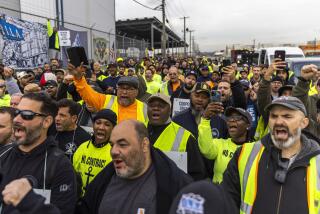Maersk Line to lay off as many as 3,000
- Share via
The struggling U.S. economy has claimed some victims that few Americans have heard of. Copenhagen-based A.P. Moller-Maersk Group, the world’s largest ocean shipping line, plans to lay off as many as 3,000 of its container division’s 25,000 workers, in part because of a slowdown in U.S. trade in 2007.
“The U.S. situation is a problem for us and for the entire industry,” said Eivind Kolding, chief executive of Maersk Line, the company’s container shipping division. “We are expecting no growth to very slow growth in the U.S. this year.”
Maersk is the biggest player in a fragmented global cargo movement industry dominated by foreign conglomerates. Maersk controls more than 16% of the world’s liner fleet, according to AXSMarine, a French maritime research company. Maersk’s fleet is so enormous that it can put to sea at once more cargo containers than all but the largest U.S. ports handle in an entire year.
Maersk Line lost $568 million in 2006, eked out only a small profit in 2007 and now must take several steps to streamline its operations, company executives said in a Tuesday conference call with reporters and financial analysts. The U.S. economy, hard hit by a real estate bust and consumer weakness related to high fuel costs, played a big role.
The effect of tightfisted shoppers is apparent at the ports of Los Angeles and Long Beach, the nation’s largest container facilities by volume. The two ports had been averaging overall cargo growth of about 10% for each of the last 14 years, but through November, they had handled about 14.4 million containers, a decline of about 100,000 from 2006.
Collectively, the 10 busiest container ports in the U.S. ended a four-month string of year-over-year cargo traffic declines last month when they recorded an increase of more than 3% over December 2006, according to a monthly report released Tuesday by the National Retail Federation and the business research firm Global Insight.
But the report also said that “the slow pace of container traffic growth is forecast to continue through May due to weakness in the U.S. economy.”
For most of this decade, Maersk Line rode the boom in globalization, tripling the size of its fleet capacity to nearly 1.8 million containers.
But its performance has faltered relative to some of its strongest competitors -- particularly Geneva-based Mediterranean Shipping Co. and CMA CGM of Marseille, France -- since it acquired rival P&O; Nedlloyd in 2005.
“The complexity has grown and so has the bureaucracy. We will remove the safety net and unnecessary controls. By doing this we will enhance focus,” Kolding said.
The Maersk Line CEO said that it was too early to tell where most of the layoffs -- the largest in the Danish company’s 104-year history -- would occur but that most of those affected would be of middle managers. In all, the parent company employs 110,000 people at operations that include an oil company and a retailer.
Local port officials were bracing for any decline in Maersk’s U.S. operations. Maersk operates the Pier 400 facility at the Port of Los Angeles, which, at 484 acres, is the world’s largest single-operator port terminal. It accounts for 22% of the L.A. port’s container traffic.
“The perception of shipping companies with huge profit margins is really outdated,” said Geraldine Knatz, executive director of the Port of Los Angeles. “These days, the lines are working with much higher operating costs and thinner margins -- and that impacts their bottom line.
“What people need to know is that Maersk isn’t just a valued tenant and a major Harbor District employer; they’re an industry leader and innovator. So we know they’ll weather this and we’ll be doing business with them for years to come.”
--
More to Read
Inside the business of entertainment
The Wide Shot brings you news, analysis and insights on everything from streaming wars to production — and what it all means for the future.
You may occasionally receive promotional content from the Los Angeles Times.











